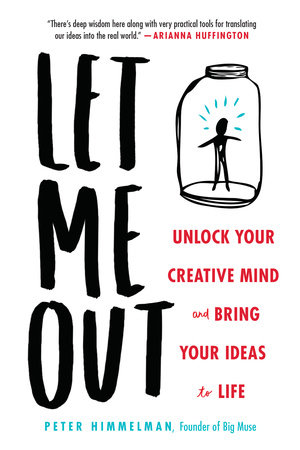
Peter Himmelman is the founder of Big Muse and the author of Let Me Out: Unlock Your Creative Mind and Bring Your Ideas to Life
We live in an ocean of judgment—”you’re not famous enough, you’re not smart enough, you’re not thin enough.” The weight of these appraisals, from others and from ourselves, can prevent us from looking at the world like a child might, as a place of wonder and new possibilities. This, in turn, keeps us from accessing the state of mind that stands at the root of creativity: playfulness.
W. Winnicott, the famed English pediatrician and psychoanalyst, wrote extensively on the subject of play. Here’s one of the ways he describes it:
Without hallucinating, the child puts out a sample of dream potential and lives with this sample in a chosen setting of fragments from external reality.
In other words, when a child is engaged in play, she is taking material from her inner reality, or dream world, and placing it into external reality, or what we might call the real world. Play then becomes the intersection of dream and reality. I call that potent, unfettered, creative mindset “Kid-Thinking.” Very young children don’t think about the consequences or how they’ll be perceived; they just play. Studies have shown that when we fully immerse ourselves in joyous doing—as opposed to anxious mulling—we can become more creative.
The biggest challenge to Kid-Thinking is the negative voice we all have in our heads. In my case, it’s the voice that just whispered, “Who are you kidding? No one really cares what you have to say,” as I was thinking about writing this piece.
I call this voice, this internal critic, Marv. Marv is my metaphor for: Majorly Afraid of Revealing Vulnerability. Whether this Marv character, (who’s actually a set of neurobiological responses from our amygdala, or primitive brain), senses danger from actual physical threats, or perceived psychological ones, his protective warning remains the same: “Stay away!” For instance, if a rabid Puma were about to pounce on you, Marv would become the lifesaver that sends adrenaline coursing through your bloodstream. On the other hand, when it’s time to call a certain woman you’ve always wanted to date, Marv becomes the saboteur that tells you all the ways you could screw up for even trying. He believes that something that could “harm” us in a purely psychological way—such as that woman turning down your offer to go to dinner—is also “deadly.” And so Marv endeavors to protect you against psychological threats as well.
Here are a three proven ways to reclaim your Kid-Thinking.
1. Set a timer.
When undertaking a daunting idea, set a timer for three minutes and begin one small piece of that task within that time. Negative judgments come only when you are fearfully weighing the possible consequences. Once you shift from ruminating to acting, you can stop negative comments.
2. Envision a positive outcome.
Take five minutes and write a detailed description of what your idea looks like in its most positive form. Use sensory images and emotional terms to help make the vision come alive. Post what you’ve written where you can see it and your fully conceived, fully positive vision becomes a potent bulwark against negativity.
3. Distinguish between fear and anxiety
You must decide whether the threats arrayed against you are real or purely psychological; for example, a rabid dog is an actual threat, vague fears of being humiliated are harmless anxiety. It’s carefully making that calculus that will allow you to ignore distracting judgments and gain access to your Kid-Thinking once again.
As for that ocean of judgment? It’s time to splash in those waves like you did when you were a kid.
More Must-Reads from TIME
- How Donald Trump Won
- The Best Inventions of 2024
- Why Sleep Is the Key to Living Longer
- Robert Zemeckis Just Wants to Move You
- How to Break 8 Toxic Communication Habits
- Nicola Coughlan Bet on Herself—And Won
- Why Vinegar Is So Good for You
- Meet TIME's Newest Class of Next Generation Leaders
Contact us at letters@time.com